Doctor Lautrec and the Forgotten Knights Review
|
|
See PixlBit's Review Policies

On 03/01/2012 at 12:00 PM by Travis Hawks Cramming every idea into one game does not make it the greatest game. |

If you are a huge fan of Pokémon, Professor Layton, block pushing puzzles, or stealth-action, a small part of this game may appeal to you.
Dr. Lautrec, a renowned Parisian puzzle-solver, is thrust into the center of a giant mystery that promises to tax your noggin as you seek the rightful heir to the French throne. At least that’s the way the game starts out. As you work to recover enchanted treasures guarded by cops and secretive knights, you end up doing lots of other things that have nothing to do with solving puzzles. Each segment of the game drags in another popular game component and tries to create the perfect combo-game that will appeal to everyone. Problem is, no single piece of Dr. Lautrec and the Forgotten Knights is particularly enjoyable, so the end product feels like a mix of bland, sequential minigames with a repetitive structure.
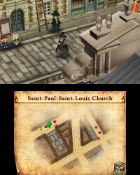
It’s hard to tell the difference between the primary and side quests since they all play out in the exact same way. Every quest starts with the receipt of a “map” or clue to guide Dr. Lautrec (in his tall brown hat) and his young assistant around 19th century Paris. Deciphering the maps’ clues smacks of edutainment, as they lead you around and teach you the history of the great French city. Strangely, it’s unclear if you’re actually learning anything at all since there’s a rather glaring caveat when you start a new game that many of the locations are fictional.
Even if the riddles deciphered in the provided maps are historically accurate (they seem to be), completing them is a chore. You basically just watch as Lautrec and Co. think through each piece of the riddle while you repeatedly press the A button to advance text. When not skipping through the text, you often have to travel to several places on the map to look for clues. You are forced to travel across the map to visit some locations only to read that “there don’t appear to be any clues here, let’s go to the next location.” You don’t actually solve anything in these sequences, but just move the characters through the riddle-solving process. It’s an amazingly mind-numbing experience for something in the guise of a brain teaser.
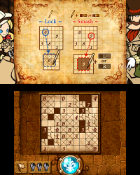
At the end of this “puzzle solving,” you have to locate a dungeon entrance and head beneath Paris to sneak past cops and reclusive knights in order to garner some Treasure Animatus. Exploring dungeons is a stealthy operation as you avoid patrolling guards, all while moving giant crates around to extend walkways and open passageways. Each room of the dungeon is set up like it’s a separate puzzle (unless it’s a simple corridor), and getting caught by a guard sends you back to the room entrance and resets any progress you made.
Small mistakes can lead to huge frustration here as some patrolling policemen and knights can have painfully slow gaits and no A.I. at all. Cleverly trying to crush a cop between crate and wall sadly leads to no gruesome animation, but it also hilariously doesn’t make him wonder why a large crate is repeatedly trying to pulverize him. These dungeon room puzzles slowly get more difficult (but not more intriguing) as you’ll tire of these same activities in the identical-looking locales just a couple of hours in.
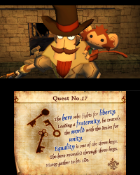
In addition to those room puzzles, there are passageways locked behind riddles. Unlike Professor Layton, there is almost no variety in the types of puzzles you will encounter, with most being a minesweeper type game, fill-in crosswords, pattern recognition, and finding the differences between two pictures. None of them are enough to keep anyone interested time and time again. If nothing else, I now have a greater appreciation for the variety and depth of the puzzles in the Professor Layton games.
Typically, behind puzzle-locked doors are Treasure Animatus, the macguffins you are searching after. When you come across one (in a rounded container with a circle latch on the front), you can initiate a battle to try and capture it for use in future conflicts. These battles are probably Doctor Lautrec’s strongest component. Yes, they are basically Pokémon at their core, but the mechanics are a bit different and can involve some interesting strategizing.
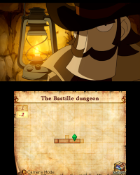
You have to select the three Treasure Animatus to bring with you at the start of any dungeon, each with its own type (avian, terrestrial, etc.), without knowing what arenas and opponents you will be facing within. Each arena has a unique setup with designated locations to place your Treasure Animatus for attacks. Some locations are cracked and decrease your attacks’ effectiveness, some are linked together to create a chaining of powers with subsequent attacks, and others will only allow Treasure Animatus of a certain affiliation to be placed on them. So, instead of relying on a set of certain attacks from each critter, the strategy comes down to the arena’s layout and the order with which you send your minions out to attack.
Don’t get me wrong, the battles aren’t perfect either. You can’t skip attack animations -- which quickly get old -- and most of the Treasure Animatus are palette swaps of the first few you ever collect. This certainly keeps you from wanting to catch them all since the only thing that significantly delineates them is their stats. It’s also too bad that learning how to chain attacks and other intricacies are never explained well and it’s usually easy enough to just send an onslaught of attacks at the target until you win without really thinking about it.

Additional filler between the battling sessions comes from the passable story and inter-character drama. The way these parts are presented is also a mish-mash. At times, the classic slide-in silhouette system is used, while other moments have well-drawn anime sequences, and still others have somewhat freakish polygonal renderings acting out the narrative. I thought the anime stylings were done the best, but I primarily wanted some consistency. Strangely, the voice acting is high quality, but there are just so many vignettes that you end up just reading through the text and skipping the chatter anyway.
That’s the main issue with Doctor Lautrec and the Forgotten Knights: you keep skipping through its patchwork of stolen game ideas hoping to find one that they got right. No single element pulls Doctor Lautrec above mediocre, and the complete package of cribbed bits doesn’t add up to something as good as the source material. If the creators had been a little more focused and decided which one of the four or five masterpieces to center the game around, it might have been successful. As it stands, Doctor Lautrec won’t satisfy fans of the games it copies or convince anyone that it has created a new recipe of delicious ingredients.








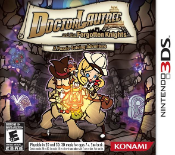


Comments